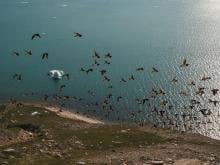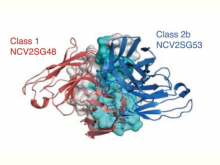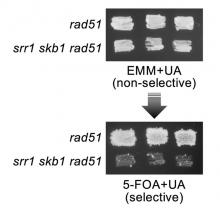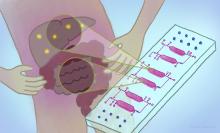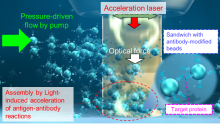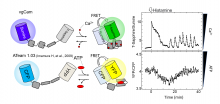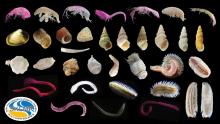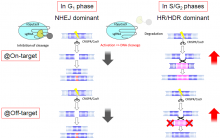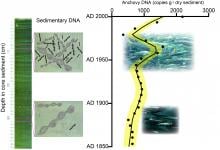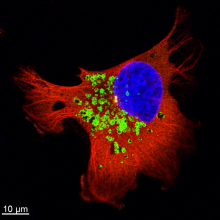Communications Biology
News
21 Dec 2023
A research group led by Osaka University and University of Hawaii Manoa found that in female fruit flies, microorganisms enhance reproductive function, boosting the number of cells that form eggs and the number of mature eggs. This is done by controlling the release of hormones to speed up cell division in the ovaries, and limiting programmed cell death. These findings could improve reproductive medicine and could aid the development of new methods to enhance fertility.
01 Sep 2023
Your eyes may reveal more than you think. That is what Tohoku University researchers have discovered, finding a link between certain types of decision making and eye movements.
26 Jun 2023
What scientists learned about the rare antibodies targeting SARS-CoV-2’s Achilles’ heel could help fine-tune our COVID-19 vaccine strategy for longer-lasting immunity.
26 May 2023
A research team, led by researchers from Osaka University, performed genetic screening of fission yeast lacking DNA repair gene Rad51 to identify genes that play a role in gross chromosomal rearrangement (GCR), a type of mutation that occurs at the centromere. Cells lacking Srr1 or Skb1 exhibited reduced GCR, indicating that these genes are important to the occurrence of GCR. These findings advance our understanding of the mechanisms underlying centromeric GCR.
07 Apr 2023
A tiny platform empowers scientists to examine how gut and liver cells interact in health and disease.
22 Dec 2022
Osaka Metropolitan University scientists discovered the principle of light-induced acceleration of antigen–antibody reaction, allowing for simple, ultrafast, and highly sensitive detection of proteins. The researchers introduced target proteins and probe particles with modified antibodies selectively binding to the target proteins into a small channel and applied irradiation with infrared laser light. They achieved, for the first time, the rapid measurement of trace amounts of attogram-level target proteins after only 3 minutes of laser irradiation. These findings will potentially contribute to breakthroughs in the development of systems for ultra-early diagnosis of various diseases.
15 Dec 2022
Researchers led by Osaka University report the development of INCIDER, a fluorescent sensor system that enables high-contrast microscopic imaging of temporal changes in cellular interactions mediated by the N-cadherin molecule. This sensor system, which emits much brighter fluorescence than the currently used system while detecting these interactions, is expected to have a wide range of applications in developmental biology, neuroscience, and other fields.
16 Nov 2022
Researchers from SANKEN (The Institute of Scientific and Industrial Research) at Osaka University have genetically engineered a protein to emit the shortest-wavelength fluorescence light reported to date. They did this by optimizing the interactions between the fluorescence center (chromophore) and its surroundings, in a manner that differs from previous reports. The resulting fluorescence emission was bright and stable over a useful range of pH values. This work will aid basic and applied research, such as understanding the behavior of healthy and diseased cells.
09 Aug 2022
Researchers at Kanazawa University report in Communications Biology that using common chemicals for fixing living cell samples for microscopy studies causes membrane proteins to aggregate.
02 Nov 2021
Malfunctioning of the so-called Hippo signalling pathway within animal cells leads to irregular activity of proteins that regulate genes involved in cell proliferation. Researchers have identified a key step in the process of this aberration, opening the door to new therapeutics for cancers such as head-and-neck squamous cell carcinoma and lung adenocarcinoma.
08 Jul 2021
Molecular evolution of enzyme beyond recruit hypothesis
●First determination of crystal structures of aconitase X by X-ray crystallographic analysis
●Evidence of a common ancestor of aconitase superfamily, appearing before the previously proposed one
●Evolutional insight of requirement of complicated metabolic pathways in primordial cell
05 May 2021
Biodiversity is of crucial importance to the marine ecosystem. The prohibition of trawling activities in the Hong Kong marine environment for two and a half years has significantly improved biodiversity, an inter-university study led by City University of Hong Kong (CityU) has found. Research results showed that the trawl ban could restore and conserve biodiversity in tropical coastal waters.
04 Dec 2020
Turning off gene-editing until it reaches cell cycle phases where more accurate repairs are likely to happen offers a promising fix to CRISPR-Cas9’s problem with unwanted genetic changes.
20 Nov 2020
A research team, affiliated with South Korea's Ulsan National Institute of Science and Technology (UNIST) has succeeded in unveiling the principle behind the changing sleep patterns, according to the ambient temperature, through the use of Drosophila as a model of sleep.
10 Nov 2020
Far too little is known about the long-term dynamics of the abundance of most macro-organism species. We used sedimentary DNA technology to quantify marine fish DNA abundance in sediment sequences spanning the last 300 years. This study first shows the existence of fish DNA in the sequences and proves that fish abundance can be tracked using sedimentary DNA, highlighting the utility of sedimentary DNA for researchers to acquire lengthy records of macro-organism species abundance.
29 Oct 2020
Scientists have revealed the molecular mechanism regulating the trafficking of lysosomes that increases the invasiveness of radioresistant cancer cells following radiotherapy.
Events
Sorry, no events coming up for this topic.
Researchers
Sorry, no researchers coming up for this topic.
Giants in history
Sorry, no researchers coming up for this topic.


